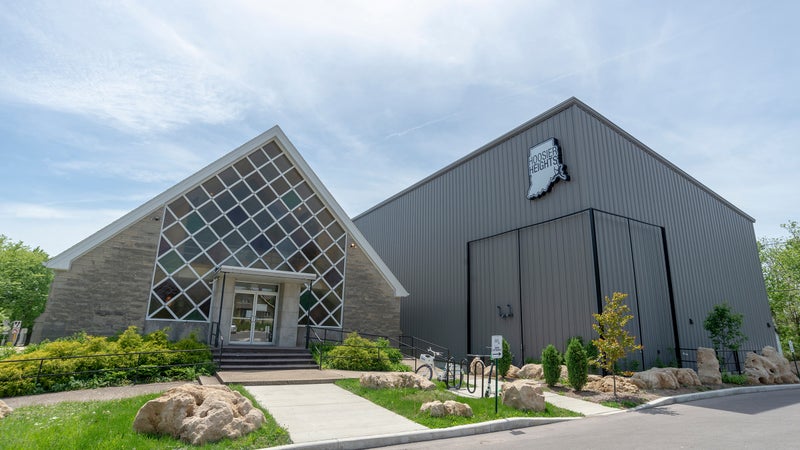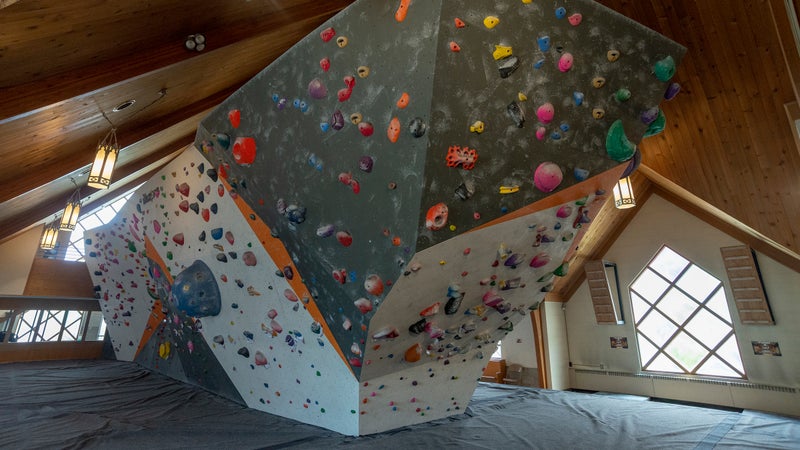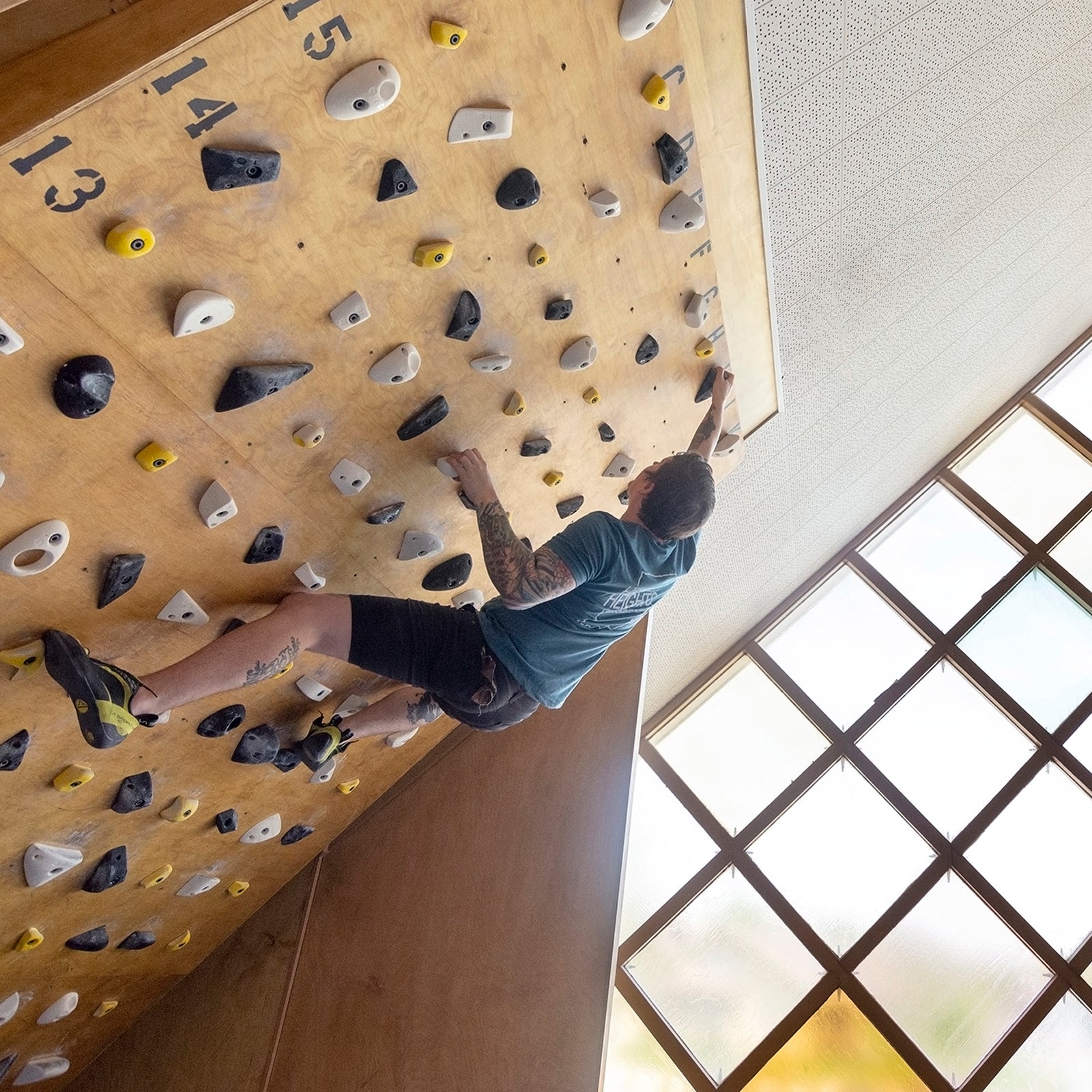For eight years, Joe Anderson drove by McDoel Baptist Church on his commute from the center of Bloomington, Indiana, to the bland exurban warehouse that housed Hoosier Heights, one of several climbing gyms he owns across the Midwest. HeÔÇÖd always admired the old churchÔÇöits limestone exterior, its historic charm. When he saw it was for sale in 2016, he had a crazy thought: Business was growing at the Bloomington gym, and he wanted to move it to a more central spot. Why not turn the church into ?
McDoelÔÇÖs congregation hated to lose its┬ábuilding, which had anchored McDoel Gardens, a neighborhood of blue-collar bungalows, since it opened in 1925. In the 1960s, the church added a second sanctuary with a capacity of around 250. ÔÇťWe would fill the whole place,ÔÇŁ remembers longtime parishioner Pat Suits, 83, who still lives one house down from the old building. ÔÇťWe had so many kids going there, a new youth group.ÔÇŁ
But like so many churches across the country, McDoelÔÇÖs membership declined in the following decades as the congregation aged and shrank. According to the , conducted by the nonpartisan research organization NORC at the University of Chicago, 2018 when Americans who didnÔÇÖt attend church outnumbered those who go every week or nearly every week. At McDoel, instead of a new generation of kids, the regulars consisted of elderly people like Suits, and their historic building was now causing them headachesÔÇöthe only bathrooms, for example, were down a long flight of stairs. Eventually, the congregation decided to sell the┬áchurch and move into a smaller space nearby.
A climbing gym might seem like a weird and worldly replacement, but a few have popped up in churches across the Rust Belt, including , and . ItÔÇÖs a match that makes sense (sanctuaries have high ceilings) but often brings distinct difficulties (sanctuaries can be too narrow for belaying). ÔÇťIÔÇÖve looked at quite a few churches,ÔÇŁ says Adam Koberna, president of U.S. operations for Walltopia, one of the worldÔÇÖs leading climbing-wall companies. ÔÇťAnd they rarely work out.ÔÇŁ

The physical structure is only part of the problem. In Cleveland, Chick Holtkamp and Niki Zmij tried to convert that was built in 1885. ÔÇťIt was a big space,ÔÇŁ Holtkamp says, ÔÇťbut more than that, it was an interesting space.ÔÇŁ They toured dozens of gyms, hired architects, gave enthusiastic interviewsÔÇöonly to watch the church theyÔÇÖd hoped to save . In the end, residents were too worried about the extra traffic that a commercial property would bring. ÔÇťHonestly, it was politics,ÔÇŁ Holtkamp says. ÔÇťThe people who didnÔÇÖt want it had a more powerful voice.ÔÇŁ
There can also be issues with historical-preservation requirements┬áand with securing the financing required to rehab a quirky old building. In Cincinnati, Chris Wiedeman and his brother, Joe, have put tens of thousands of dollars over the past year┬áinto stabilizing a beautiful, abandoned 1870s church that they hope to turn into a gym called . ÔÇťThe church has been exceedingly neglected,ÔÇŁ Chris says. ÔÇťThere were holes in the floor.ÔÇŁ The construction of the ambitious design, which highlights┬áthe buildingÔÇÖs arched windows and architectural details, is proving tricky enough, though itÔÇÖs made more feasible by the fact that Chris himself works as a general contractor. The fundraising is even trickier. ÔÇťThatÔÇÖs where weÔÇÖre running into the most trouble,ÔÇŁ he says.
In Bloomington, Joe Anderson understood the potential problems┬ábut decided to give the renovation a shot anyway. ÔÇťDoing a gym like this is a labor of love,ÔÇŁ he says. ÔÇťIt was not a purely economic decision.ÔÇŁ And it did not go smoothly at first. ÔÇťThere were literally bats in our belfry,ÔÇŁ he says, and that wasnÔÇÖt the only hiccup. Working with Walltopia to design and build the gym, he had to consider the limitations of the old structure while finding a way to support enormous freestanding climbing walls.

To pull it off, he wound up adding a second building for top roping. But, Anderson says, ÔÇťIt was important to me that you still walk in and say, Whoa, this feels like a church.ÔÇŁ┬áSo pews became seats for changing into climbing shoes. Carabiners clipped the sanctuaryÔÇÖs vintage pendant lights to the sloped ceiling, creating more clearance for the bouldering wall. The churchÔÇÖs kitchen became the spot to clean the holds, with its giant hood sucking up the vinegary smells. And the choir loft morphed into a secluded spot for advanced climbers to train on MoonBoards.
In 2018, after more than a year of construction, the facility opened with 16,000 square feet of climbing. The location, just off BloomingtonÔÇÖs popular , allows many climbers to walk or bike to the gym. ThatÔÇÖs been especially helpful in luring students from the cityÔÇÖs Indiana University; for the first time in a while, young people are filling up McDoel.
As for the McDoel congregation, it┬ástill gathers on Sunday┬áin a rented office building in the same neighborhood. The┬áservice┬áusually draws about 20 worshippers, and Pat Suits notes how thankful everyone is that the bathrooms are located on the main level. ÔÇťItÔÇÖs all just right there,ÔÇŁ she says.
Two blocks away, Hoosier Heights opens on Sundays at 9 A.M. Anderson is happy that the gym has boosted the neighborhood and that saving an old building has proven economically and environmentally sustainable. But most of all, heÔÇÖs thrilled to see so many people using the space, whether itÔÇÖs the neighborhood association hosting its annual Christmas cookie swap, just like it did at the church, or climbers reaching for their next hold as sunlight filters through the stained glass. The gym captures the sense of community┬áand wonder┬áthat has defined the┬ábuilding for close to a century. ÔÇťWe took over a place designed for positive community gatherings,ÔÇŁ says Anderson, ÔÇťand weÔÇÖre trying to still be that.ÔÇŁ


